|
< Earlier Kibitzing · PAGE 2 OF 2 ·
Later Kibitzing> |
Feb-22-17
 | | OhioChessFan: I went with 21. Rxa7+ Kxa7 22. Qd4+ Kb8 23. Ra1 |
|
Feb-22-17
 | | OhioChessFan: <Fish55> you're fine. After 21. Rxa7+ Kxa7 22. Qd4+ Kb8 23. Ra1 Be6 24. Qxa7+ Black will probably resign.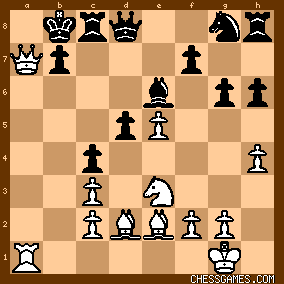
click for larger viewIf not, Nxc4 is the move that blows open the position eventually. |
|
| Feb-22-17 | | razetime: I agree with <OhioChessFan>. Rxa7 is the best move. Other variations are slow wins or equal. But Ra1 is inaccurate. better was the game continuation e6 where you get your rook back, with a nice and open king. |
|
| Feb-22-17 | | saturn2: White is a piece up but rook and queen are attacked. 21 Rxa7+ gives back the piece and 22 Qd4+ allows the double attack e6 on the bishop d7 and the rook in the corner.
If black plays 22 ..Qb6 then 23 Ra1+ wins the queen. |
|
| Feb-22-17 | | ChessHigherCat: I went with 21. Ra7+ Kxa7 22. e6 to open the diagonal for checks or at the very least win the rook back. For example 22. ...Bxe6 23. Qe4+ Kb8 23. Nxc4 threatening Bf4+ and black's ponomarian goose is cooked. |
|
| Feb-22-17 | | ChessHigherCat: I saw Ponomariov play in a championship at Hotel Metropol in Moscow in 2002. I remember a lot of people didn't take it seriously because Kasparov refused to participate. P. is definitely a very strong player but he didn't strike me as world champion material and you don't hear very much about him these days. |
|
| Feb-22-17 | | Skewbrow: Even I saw the appeal of 21.Rxa7+ Kxa7 22. Qd4+ Kb8 23. e6. Black can sort of save the hanging rook with 23. ..f6 24.exd7 Qxd7. leaving White with a pair of bishops for a rook and pawn. But I rather like White's prospects after 25.Nxd5. White still has Ra1, Bf4 and Bg4 looming and Black will have trouble handling all of those. Alternatively 25.Bg4 then wins the exchange. |
|
| Feb-22-17 | | agb2002: White has a bishop for a pawn.
Black threatens Bxg4 and Qxa5.
The rook on h8 is defenseless and if the queen or the dsb were on d4 White would create a double threat with e6. This suggests 21.Rxa7+ Kxa7 (21... Kb8 22.Qd4 + - [B]) 22.Qd4+ Kb8 (22... Qb6 23.Ra1+ wins the queen) 23.e6: A) 23... Rh7 24.exd7 Qxd7 25.Nxd5 + - [2B vs R] and threats like Bf4+, Ra1, Bxc4, etc. B) 23... Bxe6 24.Qxh8 + - [B vs P] and threats like Qe5+, Bxh6, Qg7, etc. C) 23... Ne7 24.exd7 Qxd7 25.Nxc4 + - [B vs P]. |
|
| Feb-22-17 | | Walter Glattke: 23.-Bxe6 24.Ra1 b6 25.Nxd5 Bxd5 26.Bf4+ Rd7 27.Bxd7 Kxd7 28.Ra7+ Kc6 29.Qxh8
White had a bishop for a pawn before, and the rook victim is only for the audience, no mate follows. |
|
| Feb-22-17 | | TheBish: Kasimdzhanov vs Ponomariov, 2007 White to play (21.?) "Medium/Easy"
White is up a piece for a pawn, but both his queen and rook are attacked, so it looks like he must part with the rook. Looks can be deceiving! One try that can be eliminated right away is 21. Rxd5? Bxg4 22. Rxd8 Rxd8 23. Bxg4 Rxd2, and White has dropped a rook and is now down material. So that leaves the candidate moves e6, Rxa7+ and Qd4. Only one of these can be the most accurate, right? The idea behind all of these moves is combining an attack on a7, the Bd7 (after e5-e6) and the hanging rook on h8. Let's look at all three: (A) 21. Qd4 Qxa5 22. e6 Nf6! (giving up a minor piece instead of the rook, and better than 22...Rh7 23. 23. exd7 Rd8 24. Nxd5) 23. exd7 Nxd7 (23. Qxf6 Bxe6 is worse) 24. Nxd5, when Black has a rook and pawn for two minors. (B) 21. Rxa7+ Kxa7 22. e6 (22. Qd4+ more or less transposes) 22...Nf6 23. Qd4+ Kb8 (of course not 23...Qb6?? 24. Ra1+, winning the queen) 24. exd7 Nxd7, and White has two pieces for rook and pawn, and will continue the attack with Ra1 or Qf4+ next move, which looks quite strong. (C) 21. e6 Qxa5 (not 21...Bxe6? 22. Rxa7+ Kxa7 23. Qd4+ Kb8 24. Qxh8 and White keeps his extra piece, and 21...Nf6 22. Rxa7+ transposes to line B) 22. exd7 Rd8 23. Qd4 Ne7 24. Qf6! Qc5 25. Bg4, and Black has a rook and pawn for two pieces, but will be hard-pressed to get rid of the d-pawn without losing more material, as his d- and f-pawns are targets. Both (B) and (C) look good, but I would have to go with (B), 21. Rxa7+! as it weakens the king, loosening the dark squares and opening up a path for the dark-square bishop to enter the attack. |
|
| Feb-22-17 | | YouRang: Wednesday 21.?
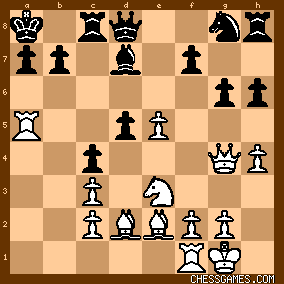
click for larger view
White is up a B for a P, but white's queen and Ra5 are both under attack, and so at first glance it appears that saving the queen would mean losing the rook. However, the queen has access to d4, which potentially forks a7 and Rh8. So, the move that struck me was <21.e6>, blocking the attack on the Q, while opening the diagonal from d4 to Rh8.
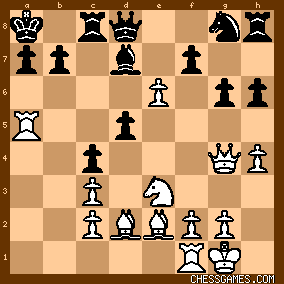
click for larger view
I figure black must either:
- Takes the Pe6: <21...Bxe6> allowing white to use the fork: <22.Rxa7+ Kxa7 23.Qd4+>  - Or take Ra5: <21...Qxa5> and then <22.exd7 Rd8> In either case, white gets out of trouble and emerges with a favorable position. |
|
| Feb-22-17 | | Oxspawn: Monday was Tuesday, Tuesday was Wednesday and Wednesday left me with a week ending.... I resign from this week. |
|
| Feb-22-17 | | gofer: Finally this week, on <Wednesday>, we have a forced combination... <21 Rxa7 ...>
21 ... Kb8
22 Qd4 
We are a piece up and threaten both Rfa1, e6, Nxd5 (followed by Bf4!) and Bg4/Bf3,
so black has to accept the rook sacrifice.
<21 ... Kxa7>
<22 Qd4+ ...>
22 ... Qb6
23 Ra1+ 
22 ... Ka6
23 Ra1+ Kb5
24 Qxd5+ mating soon
22 ... Ka8
23 Ra1+ Kb8
loses one tempo to reach the same conclusion...
<22 ... Kb8>
<23 e6 ...>
Black is left with a difficult choice either lose Rh8 and save Pd5 & Be6 or the reverse. Not an easy choice, white is likely to play Qe5+/Bf4+ at some causing nothing but misery
for black anyway, so whatever the choice black is living on borrowed time... ~~~
Resign!? That seems a little premature!
<23 ... Bxe6>
<24 Qxh8 Qf6>
<25 Qxf6 Nxf6>
<26 Nd1 ...>

click for larger viewOkay, black does have a lot to contend with; Ph6 loose and Bf4+ causing major hassle.
But resign!? Really!? Ruslan was probably mentally lost by that point anyway. I
suppose he thought <18 ... Nxa5> was okay and never really recovered from finding out
he was wrong! |
|
| Feb-22-17 | | ColeTrane: <gofer> that's right, he's resigned. You want black pieces after all that goes down...? This is one reason why I dont play internet chess, because there's rarely any considerate sportsmanship from amateurs. |
|
| Feb-22-17 | | mel gibson: My move would have been Rf1-a1 -
losing my Queen but gaining tempo for a great attack.
I tried it on the computer & it also wins. |
|
| Feb-22-17 | | gofer: <ColeTrane:> Okay, I will bite... In my recent experience, at amateur level, I have seen exactly as you say. Someone stubbornly continuing after I felt everything was done and dusted; I had just managed to promote my a pawn and my opponent played <38 ... h4>. I was a little bit shocked. It took me 6 more moves to "prove" the win at which point he did resign, but I think he wasn't completely unjustified to make me do so... 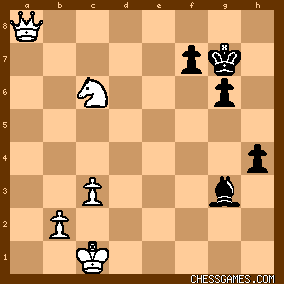
click for larger viewEqually, we have all seen the opposite too, where people resign too soon, seeing something that isn't there with best defence... We have a couple of good amateurs at my chess club and one of them loves recalling the time a 250~ ECF graded player resigned against him - <without explanation>. Our player, intrigued, stuck the position into Fritz and what did Fritz think... ...not much, position equal...
To err is human, whether you are an amateur or not... |
|
| Feb-22-17 | | AlicesKnight: I saw the game-line possibility though I muddied the waters by trying to bring the other White R in earlier. 19...exd5 opened the door; Black must have relied on 20...Bd7 as an answer but missed the Zwischenzug Rxa7. |
|
| Feb-22-17 | | kevin86: White gives up rook to give mate along bias and rook file! |
|
| Feb-22-17 | | morfishine: <21.Rxa7+> followed by <22.Qd4+> looks like a winner ***** |
|
| Feb-22-17 | | Marmot PFL: White finds the fastest win, but several other lines also seem to win as well. I went with 21 Rxa7+ Kxa7 22 Qd4+ Kb8 23 Nxd5 Be6 24 Be3, if 24...Qxd5 25 Qa7+ Kc7 26 Bb6+ and 27 Rd1 or 24...Bxd5 25 Qa7+ Kc7 26 Bb6+ |
|
| Feb-22-17 | | Pedro.Akcio: I focused too much on Ra1 :/ but I couldn't see mate. So I gave up... |
|
Feb-22-17
 | | Jimfromprovidence: No one has mentioned 21 Rxa7+ Kxa7 22 Qd4+ b6.
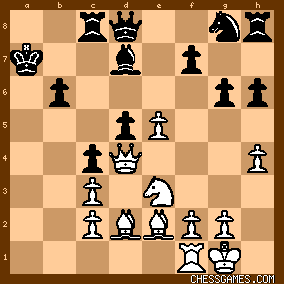
click for larger view |
|
| Feb-22-17 | | Longview: @<ColeTrane and gofer> I can relate to your expressed frustration, for and against resignation times. Our club, admittedly primarily very young players, has a rule that resignation is not done and that the winner must checkmate the opponent. This is admittedly an exercise in learning endgame play for those tournament occasions where the game is close and careful endgame maneuvers can reverse one's fortunes. I apologize for my compatriots who require you play it out longer if not completely. Personally, when I blunder and fall 5-6 pawns behind in one move, I resign in recognition of my poor play. If I know my opponent is a youth, however, I let them work me down to a checkmate with all the scrap I can muster, again in the name of their education and as a lesson to myself to not be careless next time. |
|
| Feb-22-17 | | BOSTER: Black 16...Rc8 was a blunder. |
|
| Feb-22-17 | | Sularus: took me around five minutes to solve this supposedly medium/easy puzzle. |
|
 |
|
< Earlier Kibitzing · PAGE 2 OF 2 ·
Later Kibitzing> |





